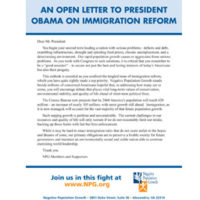Little Known Presidential Population Leadership
- Otis L. Graham, Jr
- January 19, 2013
- Forum Papers
- 0 Comments
Why was FDR not the initiator of this almost secret history of policy innovation, given his long-standing interest in social planning? His natural resource conservation commitments did not translate into activism on population growth concerns in America, chiefly because in FDR’s twelve-year presidency (1933-45) declining American birth rates and the virtual end of immigration seemed to be solving any demographic problems at home. He had a keen interest in where people lived and the New Deal was active in settlement patterns. But population growth abroad? FDR’s America expected its presidents (Hoover and Roosevelt) to be concerned about a decade-long depression at home.
This soon changed. Rising global fertility and longevity rates and larger immigration flows after World War II attracted the worried attention of presidents from Eisenhower (Truman, if post-presidential conversion counts) to Nixon who incrementally and cautiously took the lead in policy reassessments on the demographic dimension of environmental protection.
How did demography – population numbers and how they are trending, with what costs and benefits – get on the agenda of these presidents?
How not! There were 4 million Americans at the time of George Washington’s presidency, 151 million when Truman took the oath, and the numbers mounted on. The global population numbers and trends were even more alarming. Two best selling and widely influential books, William Vogt’s Road to Survival and Fairfield Osborn’s Our Plundered Planet in 1948, told millions of Americans where the global numbers were going, and the grim implications. I have not found direct evidence that President Truman read either book but they were topics of discussion among his foreign policy advisors and Washington elites. In l953, at least, Truman wrote a letter to Osborn expressing a desire to explain to him that the president’s Point IV economic aid program would soon reduce world poverty and ease the population problem so troubling the author of Our Plundered Planet. Demographers searched for ways to simplify the basic numbers telling the planetary population story. One version: The global human population reached 1 billion by Jesus’ day, doubled to 2 billion by 1830, accelerated to add a 3rd billion again in 100 years (1930), and the 4th billion came in just 30 years (1960). Truman, like many others, slowly came to regard this as a crisis for humanity.
- Little Known Presidential Population Leadership - January 19, 2013
- Immigration Reform and America’s Unchosen Future - November 3, 2009
- Immigration and America’s Unchosen Future - September 10, 2009

